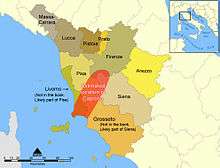The Magicians of Caprona
 First edition | |
| Author | Diana Wynne Jones |
|---|---|
| Cover artist | Ionicus[1] |
| Country | United Kingdom |
| Language | English |
| Series | Chrestomanci |
| Genre | Children's fantasy novel |
| Publisher | Macmillan |
Publication date | 1980 |
| Media type | Print (hardcover) |
| Pages | 223 pp [1] |
| ISBN | 978-0-333-27891-8 |
| Preceded by | Charmed Life |
| Followed by | Witch Week |

The Magicians of Caprona is a children's fantasy novel by British author Diana Wynne Jones published by MacMillan Children's Books in 1980. It was the second published of seven Chrestomanci books.[2]
It features the venerable Italian family spell-houses Casa Montana and Casa Petrocchi in Caprona, a small independent city-state and duchy.[lower-alpha 1]
The Chrestomanci books are collectively named for a powerful enchanter and British government official in a world parallel to ours, who supervises the use of magic —or the Chrestomanci, an office that requires a powerful enchanter and is responsible for supervising. The Magicians of Caprona is set in our time, during the tenure of Christopher Chant, who is Chrestomanci in five of the seven books and is often called Chrestomanci as a personal name.
Plot summary
Caprona is a city-state in the Italy of Chrestomanci's world (World Twelve A), which never united as a nation-state. The houses of Casa Montana and Casa Petrocchi, both renowned for being powerful magician families, have been feuding with each other for generations. The city has begun to lose its "virtue," and the states of Florence, Siena, and Pisa intend to take advantage of this by uniting to conquer Caprona. The only way to save the city is if the true words to the Angel of Caprona, both a hymn and a powerful spell, can be found and read aloud.
The story is told through the eyes of the young Tonino Montana and his brother Paolo. They are both members of Casa Montana, one of two spell-houses in Caprona, the other being Casa Petrocchi. The two spell-houses are deadly rivals; the two families are both convinced that the decline of Caprona is all the fault of the other spell-house, and refuse to work together under any circumstances.
Tonino is, unknown to himself or the rest of Casa Montana, a talented enchanter; however, he is unaware of his ability, and prefers to spend his time reading. Paolo is more outgoing and friendly, and does better at school. When representatives of both houses are called to the Duke of Caprona's palace, they both go. Whilst there, they meet members of the Petrocchi family for the first time, and they also encounter the Duchess, a powerful woman who appears to be the true ruler of Caprona.
Allusions/References to other works
The family feud between Casa Montana and Casa Petrocchi is reminiscent of the one between the Montagues and Capulets from Shakespeare's Romeo and Juliet. The Duke of Caprona also makes a reference to the Roman Emperor Nero who, according to legend, played the fiddle (or lyre) while Rome burned. Caprona has declared war and shots are being fired throughout the city and the Duke is looking out the window while singing. He breaks off to comment to a courtier, "Ah, Pollio, there's nothing like a good song while Caprona burns! Nero did it, and now me."
Notes
- ↑ Fictional Caprona is on the coast not far from the Italian Riviera, presumably south of Pisa because it borders on Pisa, Florence, and Siena exclusively and in a world that is parallel and close to ours.
References
- 1 2 The infobox provides data from ISFDB for the first UK edition (from "Publisher" to "ISBN number"). The Magicians of Caprona (first edition) publication contents at the Internet Speculative Fiction Database. Retrieved 2012-04-28.
- ↑ Chrestomanci series at ISFDB.
- Citations
Chrestomanci series listing at the Internet Speculative Fiction Database (ISFDB). Retrieved 2012-04-28.
• Select a title to see its linked publication history and general information. Select a particular edition (title) for more data at that level, such as a front cover image or linked contents.